Zen and Vega DDR4 Memory Scaling on AMD's APUs
by Gavin Bonshor on June 28, 2018 9:00 AM EST- Posted in
- CPUs
- Memory
- G.Skill
- AMD
- DDR4
- DRAM
- APU
- Ryzen
- Raven Ridge
- Scaling
- Ryzen 3 2200G
- Ryzen 5 2400G
Discrete Gaming Performance
As stated on the first page, here we take both APUs from DDR4-2133 to DDR4-3466 and run our testing suite at each stage. For our gaming tests, we are only concerned with real-world resolutions and settings for these games. It would be fairly easy to adjust the settings in each game to a CPU limited scenario, however the results from such a test are mostly pointless and non-transferable to the real world in our view. Scaling takes many forms, based on GPU, resolution, detail levels, and settings, so we want to make sure the results correlate to what users will see day-to-day.
Civilization 6
First up in our APU gaming tests is Civilization 6. Originally penned by Sid Meier and his team, the Civ series of turn-based strategy games are a cult classic, and many an excuse for an all-nighter trying to get Gandhi to declare war on you due to an integer overflow. Truth be told I never actually played the first version, but every edition from the second to the sixth, including the fourth as voiced by the late Leonard Nimoy, it a game that is easy to pick up, but hard to master.

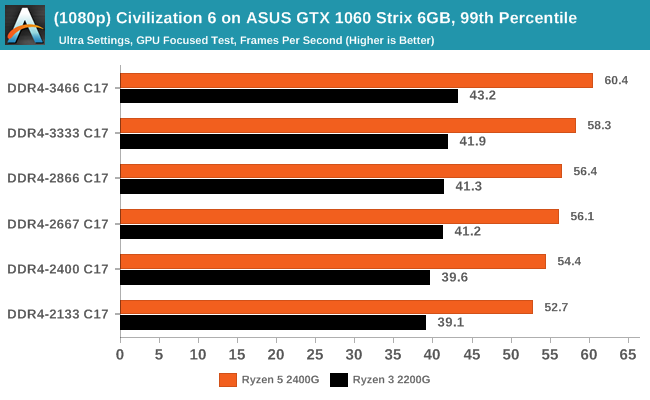
In Civilization 6, both CPUs scored a 10+% gain in both average frame rates and percentile gains.
Ashes of the Singularity (DX12)
Seen as the holy child of DX12, Ashes of the Singularity (AoTS, or just Ashes) has been the first title to actively go and explore as many of the DX12 features as it possibly can. Stardock, the developer behind the Nitrous engine which powers the game, has ensured that the real-time strategy title takes advantage of multiple cores and multiple graphics cards, in as many configurations as possible.
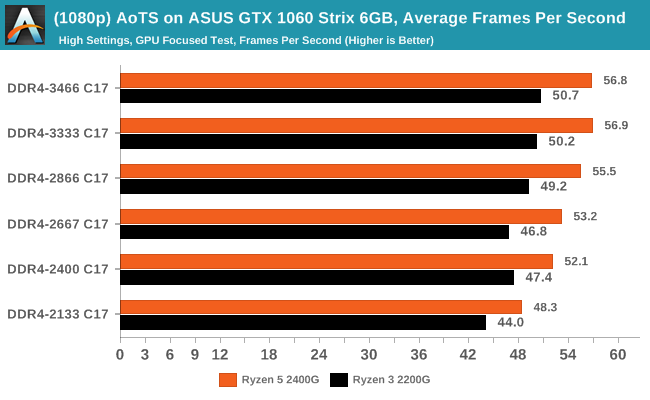

Ashes was again a little inconsistent in its results with memory using a discrete GPU, with gains avaialble on average frame rates up to about DDR4-2866 but beyond this there was not much more.
Rise Of The Tomb Raider (DX12)
One of the newest games in the gaming benchmark suite is Rise of the Tomb Raider (RoTR), developed by Crystal Dynamics, and the sequel to the popular Tomb Raider which was loved for its automated benchmark mode. But don’t let that fool you: the benchmark mode in RoTR is very much different this time around. Visually, the previous Tomb Raider pushed realism to the limits with features such as TressFX, and the new RoTR goes one stage further when it comes to graphics fidelity. This leads to an interesting set of requirements in hardware: some sections of the game are typically GPU limited, whereas others with a lot of long-range physics can be CPU limited, depending on how the driver can translate the DirectX 12 workload.
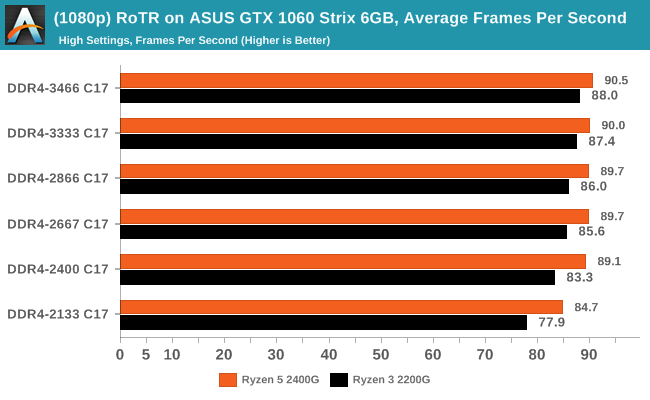
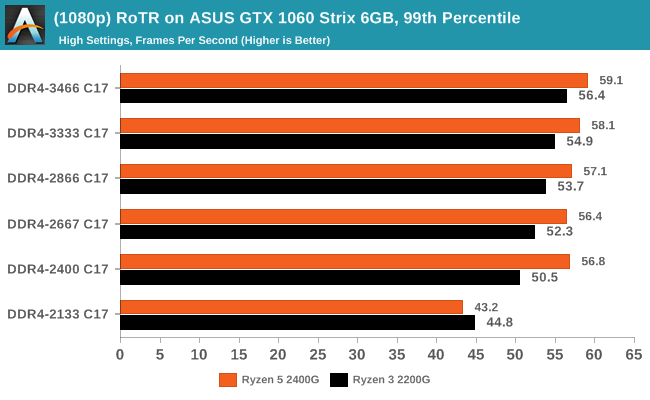
Similar to Ashes, RoTR only sees gains from the base memory opyion. That being said, the Ryzen 3 2200G did get additional boosts in the percentile frame rates going up to DDR4-3466.
Shadow of Mordor
The next title in our testing is a battle of system performance with the open world action-adventure title, Middle Earth: Shadow of Mordor (SoM for short). Produced by Monolith and using the LithTech Jupiter EX engine and numerous detail add-ons, SoM goes for detail and complexity. The main story itself was written by the same writer as Red Dead Redemption, and it received Zero Punctuation’s Game of The Year in 2014.
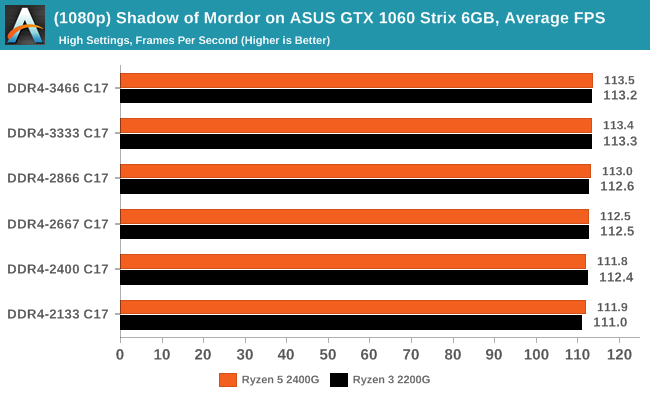
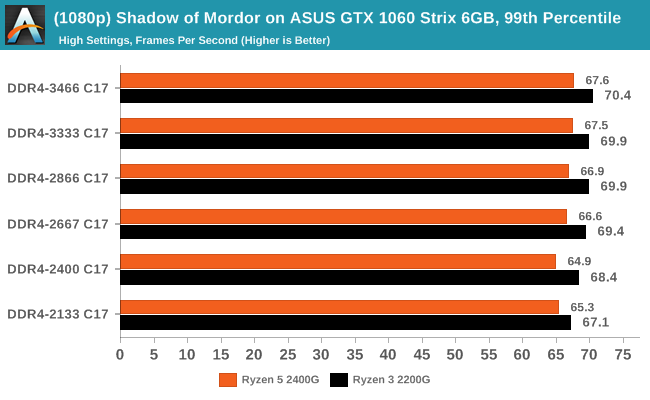
Mordor seeminly prefers its processor without SMT. Raising the memory saw small gains in percentile rates.
F1 2017
Released in the same year as the title suggests, F1 2017 is the ninth variant of the franchise to be published and developed by Codemasters. The game is based around the F1 2017 season and has been and licensed by the sports official governing body, the Federation Internationale de l’Automobile (FIA). F1 2017 features all twenty racing circuits, all twenty drivers across ten teams and allows F1 fans to immerse themselves into the world of Formula One with a rather comprehensive world championship season mode.
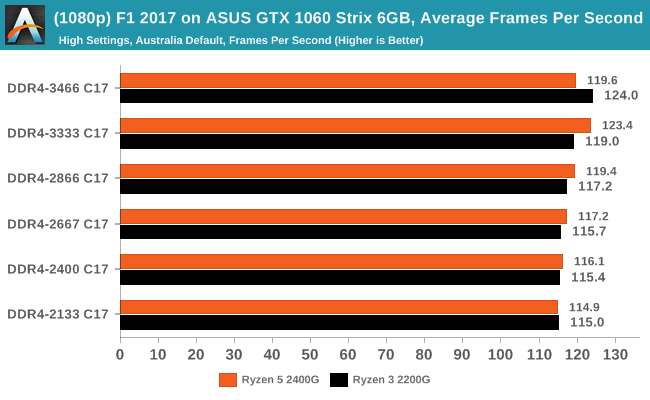
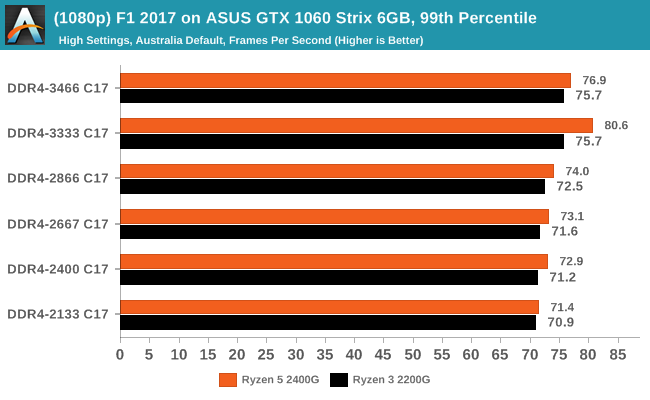
Total War: WARHAMMER 2
Not only is the Total War franchise one of the most popular real-time tactical strategy titles of all time, but Sega delve into multiple worlds such as the Roman Empire, Napoleonic era and even Attila the Hun, but more recently they nosedived into the world of Games Workshop via the WARHAMMER series. Developers Creative Assembly have used their latest RTS battle title with the much talked about DirectX 12 API, just like the original version, Total War: WARHAMMER, so that this title can benefit from all the associated features that comes with it. The game itself is very CPU intensive and is capable of pushing any top end system to their limits.
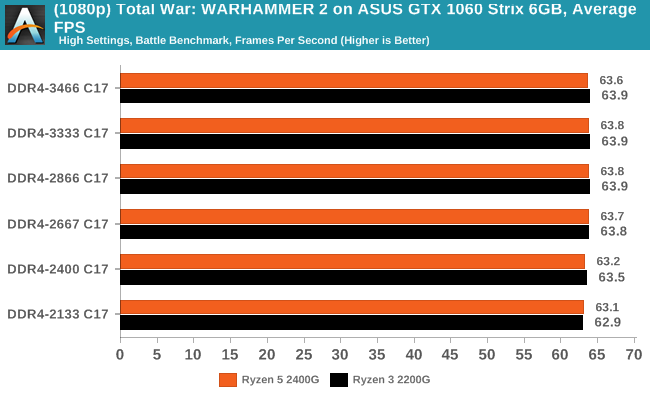
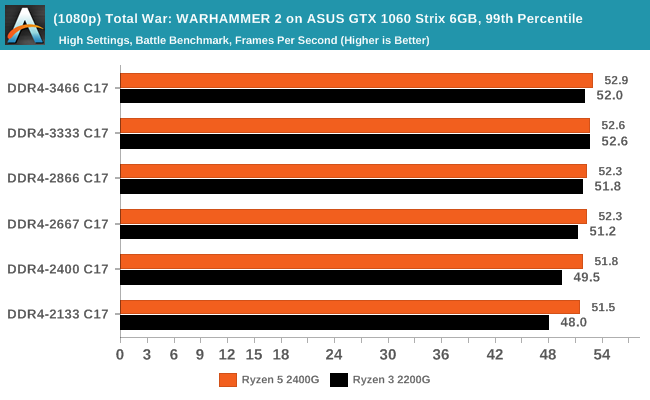










74 Comments
View All Comments
gavbon - Monday, July 2, 2018 - link
I really appreciate it, I have said all along that iGPU is coming, I'm working on it now currently and I'm currently looking at which variables to consider during the testing. As for memory, capacity doesn't have any bearing on performance other than in situations where memory is running at maximum capacity.Soon as I work out the tests I'm going to run, I can crack on! :D
hansmuff - Thursday, June 28, 2018 - link
Please someone tell me how to get that particular recommended G.Skill set to work at 2933 on a 2400G CPU. I haven't been able to get it past 2100 with Prime95 stability. What am I doing wrong?Gigabyte AB350N motherboard latest BIOS
Thanks
DennisSmith - Thursday, July 5, 2018 - link
Hi hansmuff, I just had a similar problem with a 2400G and ASRock AB350M build. Reading the MB manual, I noticed they recommend when installing only 2 sticks to use DIMM slots 2 & 4 rather than 1 & 3. After making that change, I reached the rated 3200 speed after enabling XMP in the UEFI / BIOS, and I am stable at 3400 now using the Master Ryzen Software to set the frequency (3400 is not an option in the UEFI menu).Lolimaster - Friday, June 29, 2018 - link
Again doing review the wrong way, 3466 with too high latencies and for the sake of being "consistent" all the slower dram setting are getting injured by the "global" latency for the sake of being consistent.Just do a CL15 across all kits.
Vatharian - Friday, June 29, 2018 - link
To some degree he is right - Jedec has in specification, that modules regardless of speed must support 2133 or more recently 2666 MHz. Faster modules accelerate only by manually inputing over 40 parameters or loading them up from XMP profiles. And as a matter of fact I have only seen two modules that support 'base' speed of 2666 instead of 2133 MHz.Truth is, XMP is a stop-gap, JEDEC should have prepared something universal that will do XMP's job, otherwise only thing that's left is memory ladder like ramp-up that is not fault proof, and good luck on eight module four channels that work on 4200+ MHz, you'll get boot times in range of five minutes.
plonk420 - Saturday, June 30, 2018 - link
i hope this doesn't get buried, but could you do some tests that use the CPU on just 1 stick of RAM? i built a distributed computing box and as my budget wouldn't allow at the time, just got 1 4GB stick of DDR4-2400. and i'm still only at ~66-75% memory use with some of World Community Grid's more memory intensive programs PLUS 3 instances of MilkyWay@Home on the GPUGreenReaper - Saturday, June 30, 2018 - link
If you don't want to get buried, don't call yourself plonk - it's the sound a user makes when they're added to a Usenet killfile!peevee - Tuesday, July 3, 2018 - link
"just got 1 4GB stick of DDR4-2400. "Why even bother to build such a joke?
SanX - Sunday, July 1, 2018 - link
On a different note with memory speed not related to higher frequency per single channel. There existed dual channel, quad channel, even eight channel memory architectures. Can anyone show the applications which benefit from this the most? For example are Gauss elimination matrix equation solvers or particle movement or PIC methods or even some games actually memory bandwidth bound? If yes do we get 2x, 4x or 8x increases in performances with such architectures? That where people may actually say WOW.Ian?
Cloakstar - Monday, July 2, 2018 - link
This is not a full memory scaling test. Where is the testing for scaling out to 4 sticks of RAM and bank/channel interleaving? I have found this to be critical to getting the most FPS out of prior generation AMD APU's.